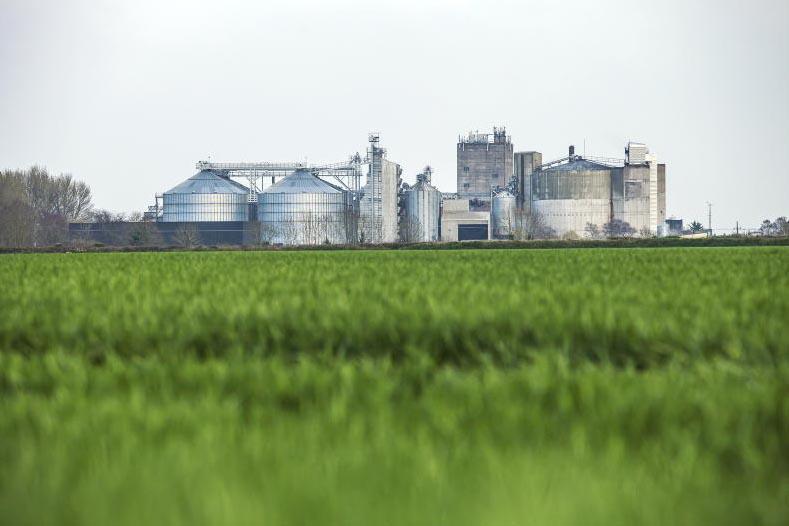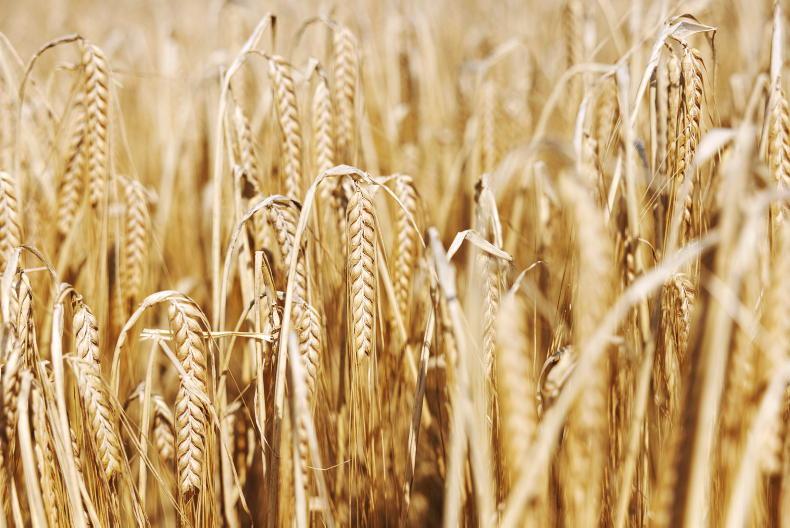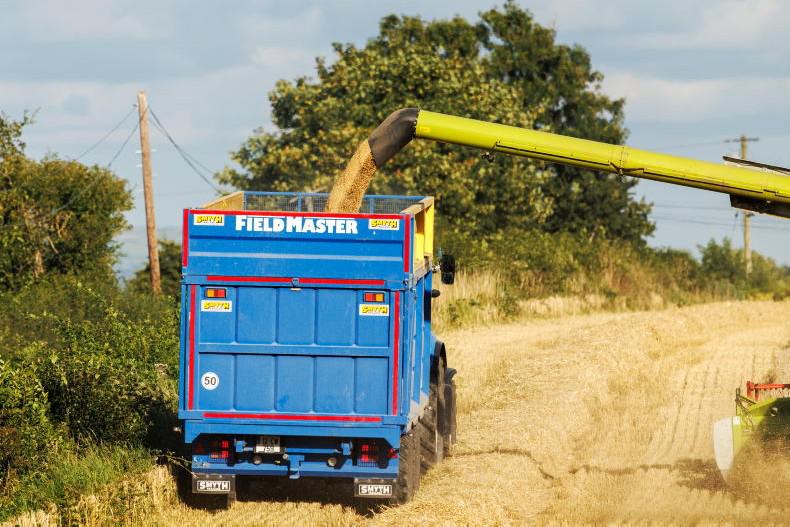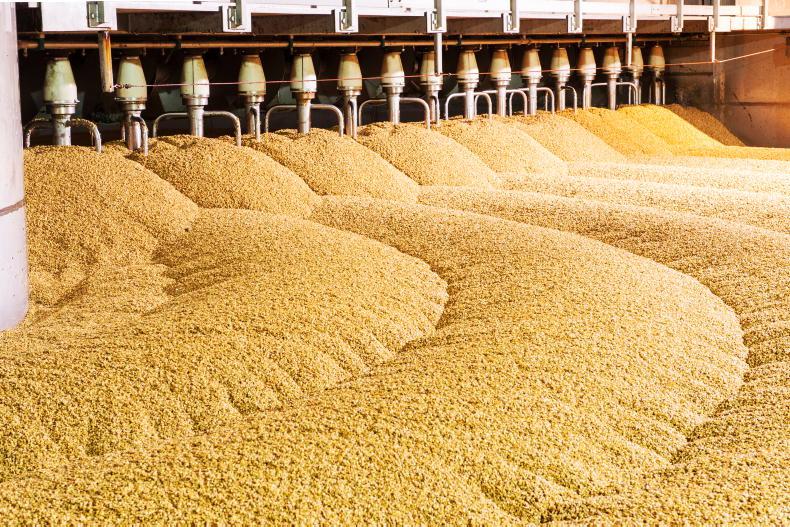The malting barley industry in Ireland is extremely important. The grain provides growers with a vital premium which can be the difference between a farm making a profit or not.
It is also a very important industry for the drinks sector as many Irish drinks producers have built their name and brand based on the story of Irish farmers growing grain to supply a local brewery or distillery.
For example, the one million visitors to the Guinness Storehouse annually are told that Guinness uses approximately 140,000t of Irish barley each year.
However, malting barley is also a crop that comes with a lot of risk. Some farmers will cut nitrogen rates to try and meet low protein specifications.
In recent years, a lack of change to varieties being accepted by some assemblers also means that growers are growing varieties that may not be as high yielding as other varieties and varieties which have poor straw strength and disease resistance, likely meaning that they cost more to grow and carry a higher risk of failure at the weighbridge.
Overall, they are less sustainable than newer varieties.
Most malting barley grown in Ireland is grown for Boortmalt, but the farmer no longer supplies barley directly to the malster.
A number of merchants across the country now assemble barley for Boortmalt and are effectively the middle man between the farmer and Boortmalt.
The malting barley premium is something farmers need to hold onto in Ireland, but growers also need certainty in cropping plans and tonnages.
Meeting
They need that certainty before cropping plans are made and seed is ordered and they need a premium to account for yield loss or higher input costs.
Last year that premium was between €40/t and €50/t over feed barley.
Farmers can attend a growers meeting in The Woodford Dolmen Hotel, Co Carlow on Monday, 10 March at 8pm. The IFA and Boortmalt will speak at the meeting to inform growers on what is happening and give context to recent events.
The meeting comes as farmers across the country have started planting barley and long after cropping plans have been made. It comes following cuts to Boortmalt contracts and a forward price offer of €230/t, just €20/t above some feed prices, which was reported to have poor uptake.
At the end of January, rumours circled that Boortmalt were cutting contracts. In early February the Irish Farmers Journal published that merchants had received news of cuts to contracts. However, some merchants did not apply cuts to growers’ tonnages.
Some background on Boortmalt
Boortmalt is owned by Axereal – a French farmers co-op. The company first came to Ireland in 2010 when Greencore sold Minch Malt. Boortmalt is the biggest malting company in the World, producing about 3m tonnes of malt in 27 malting plants and five continents.
The company is based in Athy, Co Kildare in Ireland and its plant has grown significantly in recent years. In January 2020, it opened a new plant with capacity for 40,000t and in total the site can now take in 180,000t of green malting barley per year.
Work has started on further expansion which would require another 25,000t of malting barley, bringing the total intake to approximately 205,000t.
In recent years, Boortmalt has changed its supply chain. Grain merchants now supply the company and no farmers supply grain directly to Boortmalt.
The company is often in the headlines, whether that be on price, a €10/t charge to growers, contracts or intake requirements. In 2023, some grain intakes had rejection rates of 90% on malting barley.
Top 10 questions Boortmalt needs to answer
1 Why have merchants’
tonnages/contracts been cut?
2 Why was this cut
so late in the season?
3 Why were some merchants hit worse than others, or were they?
4 Why was there no forward
price offer in the autumn time?
5 How is Boortmalt going to fill its Athy plant with barley? Where will barley come from if they are cutting contracts and expanding plant capacity?
6 Will the FOB Creil Planet price be made available to farmers or merchants?
7 How can growers trust Boortmalt in the future if major changes, like contract cuts, are made when cropping plans are in place and seed is ordered?
8 What is the €10/t charge on the harvest price for?
9 What is the
€1.05/t levy for?
10 When will Boortmalt
upgrade its variety selection?
In 2019, the IFA and Boortmalt made a major breakthrough on pricing. It was agreed that the malting barley harvest price would be based on an average price from mid-April to mid-September.
The Free-On-Board (FOB) Creil Planet price for malting barley would be taken at the close of business on Wednesday of each week and at the end of the time period the average of those prices would be used as the harvest price. Growers were paid €10/t more for supplying lower-protein distilling barley.
The price being used to calculate the average is a dried price for farmers in France. However, Irish growers are being paid the dried price as a green price.
This was done as the cost of drying the barley was basically equivalent to the cost of transporting the barley from abroad to Ireland. It placed a value on Irish barley and recognised the fact that Irish drinks manufacturers need Irish grain to market and sell their produce.
Over that time growers were also given the chance to fix the price of up to 40% of their barley. Price offers in autumn/winter and spring were released each year and growers could fix up to 20% of their barley on each offer and up to 40% in total. No price offer was released in autumn 2024.
There were no requirements for growers to supply this barley as there would be with a forward sale. This recognised the fact that malting barley comes with a high possibility of failing specifications in a given season with weather being a big factor.
Growers have generally been very happy with this pricing model and it has offered them a premium in the market.
However, growers do not have sight of this market. It is a small market and prices traded are not freely available like the London, French or Chicago wheat prices for example.
The Irish Farmers Journal receives a price from Boortmalt each week during the averaging time period. However, we cannot see the actual market. The IFA also receives that price from Boortmalt.
Boortmalt tried to introduce an energy charge of €12.50/t in August 2022. This charge would not apply to barley for which the price was fixed.
Growers first heard of the charge when the majority of malting barley had been harvested and delivered at among record low moisture levels of 11-15%. The charge was dropped.
In 2023, a €10/t charge for drying and logistics was eventually introduced by the company and has remained in place on the harvest price. It does not apply to fixed prices.
With little barley forward sold this season, to put this charge into perspective 180,000t of barley multiplied by a €10/t charge equates to €1.8m.
Where could growers’
money be going?
The €10/t charge looks to be a charge to reduce business costs or to bring the price back on a parity with the European price for malting barley.
In 2023, merchants were also charged €1.05/t (85c for food safety, research and development and 20c for the IFA levy). In 2024, merchants were charged €1.05/t again, but Boortmalt no longer collected the IFA levy. The IFA levy is now being collected by the merchants, if it is collected.
Since the IFA levy is no longer being collected by Boortmalt it would be expected that the €1.05/t levy would decline to 85c/t, but it hasn’t. To put this into perspective if 20c was collected on 180,000t of barley this equates to €36,000.
That’s €6,000 more than the average tillage farm income estimated by Teagasc for 2024.
The Irish Farmers Journal understands the 19c research levy may be part of the €1.05/t. This 19c was previously associated with the IFA levy. On 180,000t this equates to €34,200, again higher than the average tillage farm income.
Last year the Teagasc/Boortmalt joint programme finished three months early.
Teagasc and Boortmalt have told the Irish Farmers Journal that phase three of this programme is under discussion.
Boortmalt has told the Irish Farmers Journal it is doing research on malting the variety SY Tennyson.
It is understood some of this €1.05/t levy goes to due diligence like glyphosate testing.
However, merchants carry out glyphosate testing at the weighbridge. Food safety testing would be considered a business cost, similar to grain quality testing.
Other merchants across the country do not charge farmers for testing grain or for food safety checks as far as the Irish Farmers Journal is aware.
Demand for malting barley and drinks to continue
Since Boortmalt cuts were confirmed by merchants the other major malster in Ireland, the Malting Company of Ireland, has confirmed that there will not be any cuts to contracts at their suppliers – Tirlán and Dairygold.
MCI said it wanted to “provide certainty to our growers as they prepare for the season ahead”. MCI is currently working on plans to expand by 25,000t and said irish barley is essential to this.
Director of the Irish Whiskey Association Eoin Ó Catháin told the Irish Farmers Journal that “all spirits categories are currently experiencing challenges due to various factors including the impact of inflation, rises in the cost-of-business and market-specific issues such as over-stocking”.
He noted that “any significant change to trade policy in our most important export markets could also prove challenging”.
Eoin said: “We have also seen very positive growth for Irish Whiskey in a number of established and emerging markets. As mentioned, global sales of Irish Whiskey reached 15.5 million cases in 2023 and our trajectory remains positive, towards further growth.
“Our member companies are innovative and resilient. Demand for Irish Whiskey will always be there, and it will grow,” he said.
He added: “Overall growth in the Irish Whiskey category will be positive for the Irish tillage sector. The relationship between Irish Whiskey producers and the agriculture and tillage industries in Ireland is extremely important. As the demand for Irish Whiskey has grown internationally in the last 15 years, so too has the demand for Irish grain.
“In particular, a strong future focus on Irish pot still, targeting the premium segment of the market, will bring benefits to the Irish tillage sector.
“As we remain on a trajectory towards further growth, this will in turn require greater use of Irish grain.
“As distilling and brewing sector companies seek to reduce their carbon footprint and incentivise regenerative and local agriculture, the use of local grain will too grow.”
In Ireland, any barley destined for the drinks sector cannot receive glyphosate pre-harvest. So malting barley, roasting barley and feed barley for milling in the drinks industry cannot have glyphosate applied.
This is not the case in all malting barley markets, so this means Irish barley cannot be easily replaced with imports. For instance, malting barley growers in the UK can apply glyphosate pre-harvest.
The malting barley industry in Ireland is extremely important. The grain provides growers with a vital premium which can be the difference between a farm making a profit or not.
It is also a very important industry for the drinks sector as many Irish drinks producers have built their name and brand based on the story of Irish farmers growing grain to supply a local brewery or distillery.
For example, the one million visitors to the Guinness Storehouse annually are told that Guinness uses approximately 140,000t of Irish barley each year.
However, malting barley is also a crop that comes with a lot of risk. Some farmers will cut nitrogen rates to try and meet low protein specifications.
In recent years, a lack of change to varieties being accepted by some assemblers also means that growers are growing varieties that may not be as high yielding as other varieties and varieties which have poor straw strength and disease resistance, likely meaning that they cost more to grow and carry a higher risk of failure at the weighbridge.
Overall, they are less sustainable than newer varieties.
Most malting barley grown in Ireland is grown for Boortmalt, but the farmer no longer supplies barley directly to the malster.
A number of merchants across the country now assemble barley for Boortmalt and are effectively the middle man between the farmer and Boortmalt.
The malting barley premium is something farmers need to hold onto in Ireland, but growers also need certainty in cropping plans and tonnages.
Meeting
They need that certainty before cropping plans are made and seed is ordered and they need a premium to account for yield loss or higher input costs.
Last year that premium was between €40/t and €50/t over feed barley.
Farmers can attend a growers meeting in The Woodford Dolmen Hotel, Co Carlow on Monday, 10 March at 8pm. The IFA and Boortmalt will speak at the meeting to inform growers on what is happening and give context to recent events.
The meeting comes as farmers across the country have started planting barley and long after cropping plans have been made. It comes following cuts to Boortmalt contracts and a forward price offer of €230/t, just €20/t above some feed prices, which was reported to have poor uptake.
At the end of January, rumours circled that Boortmalt were cutting contracts. In early February the Irish Farmers Journal published that merchants had received news of cuts to contracts. However, some merchants did not apply cuts to growers’ tonnages.
Some background on Boortmalt
Boortmalt is owned by Axereal – a French farmers co-op. The company first came to Ireland in 2010 when Greencore sold Minch Malt. Boortmalt is the biggest malting company in the World, producing about 3m tonnes of malt in 27 malting plants and five continents.
The company is based in Athy, Co Kildare in Ireland and its plant has grown significantly in recent years. In January 2020, it opened a new plant with capacity for 40,000t and in total the site can now take in 180,000t of green malting barley per year.
Work has started on further expansion which would require another 25,000t of malting barley, bringing the total intake to approximately 205,000t.
In recent years, Boortmalt has changed its supply chain. Grain merchants now supply the company and no farmers supply grain directly to Boortmalt.
The company is often in the headlines, whether that be on price, a €10/t charge to growers, contracts or intake requirements. In 2023, some grain intakes had rejection rates of 90% on malting barley.
Top 10 questions Boortmalt needs to answer
1 Why have merchants’
tonnages/contracts been cut?
2 Why was this cut
so late in the season?
3 Why were some merchants hit worse than others, or were they?
4 Why was there no forward
price offer in the autumn time?
5 How is Boortmalt going to fill its Athy plant with barley? Where will barley come from if they are cutting contracts and expanding plant capacity?
6 Will the FOB Creil Planet price be made available to farmers or merchants?
7 How can growers trust Boortmalt in the future if major changes, like contract cuts, are made when cropping plans are in place and seed is ordered?
8 What is the €10/t charge on the harvest price for?
9 What is the
€1.05/t levy for?
10 When will Boortmalt
upgrade its variety selection?
In 2019, the IFA and Boortmalt made a major breakthrough on pricing. It was agreed that the malting barley harvest price would be based on an average price from mid-April to mid-September.
The Free-On-Board (FOB) Creil Planet price for malting barley would be taken at the close of business on Wednesday of each week and at the end of the time period the average of those prices would be used as the harvest price. Growers were paid €10/t more for supplying lower-protein distilling barley.
The price being used to calculate the average is a dried price for farmers in France. However, Irish growers are being paid the dried price as a green price.
This was done as the cost of drying the barley was basically equivalent to the cost of transporting the barley from abroad to Ireland. It placed a value on Irish barley and recognised the fact that Irish drinks manufacturers need Irish grain to market and sell their produce.
Over that time growers were also given the chance to fix the price of up to 40% of their barley. Price offers in autumn/winter and spring were released each year and growers could fix up to 20% of their barley on each offer and up to 40% in total. No price offer was released in autumn 2024.
There were no requirements for growers to supply this barley as there would be with a forward sale. This recognised the fact that malting barley comes with a high possibility of failing specifications in a given season with weather being a big factor.
Growers have generally been very happy with this pricing model and it has offered them a premium in the market.
However, growers do not have sight of this market. It is a small market and prices traded are not freely available like the London, French or Chicago wheat prices for example.
The Irish Farmers Journal receives a price from Boortmalt each week during the averaging time period. However, we cannot see the actual market. The IFA also receives that price from Boortmalt.
Boortmalt tried to introduce an energy charge of €12.50/t in August 2022. This charge would not apply to barley for which the price was fixed.
Growers first heard of the charge when the majority of malting barley had been harvested and delivered at among record low moisture levels of 11-15%. The charge was dropped.
In 2023, a €10/t charge for drying and logistics was eventually introduced by the company and has remained in place on the harvest price. It does not apply to fixed prices.
With little barley forward sold this season, to put this charge into perspective 180,000t of barley multiplied by a €10/t charge equates to €1.8m.
Where could growers’
money be going?
The €10/t charge looks to be a charge to reduce business costs or to bring the price back on a parity with the European price for malting barley.
In 2023, merchants were also charged €1.05/t (85c for food safety, research and development and 20c for the IFA levy). In 2024, merchants were charged €1.05/t again, but Boortmalt no longer collected the IFA levy. The IFA levy is now being collected by the merchants, if it is collected.
Since the IFA levy is no longer being collected by Boortmalt it would be expected that the €1.05/t levy would decline to 85c/t, but it hasn’t. To put this into perspective if 20c was collected on 180,000t of barley this equates to €36,000.
That’s €6,000 more than the average tillage farm income estimated by Teagasc for 2024.
The Irish Farmers Journal understands the 19c research levy may be part of the €1.05/t. This 19c was previously associated with the IFA levy. On 180,000t this equates to €34,200, again higher than the average tillage farm income.
Last year the Teagasc/Boortmalt joint programme finished three months early.
Teagasc and Boortmalt have told the Irish Farmers Journal that phase three of this programme is under discussion.
Boortmalt has told the Irish Farmers Journal it is doing research on malting the variety SY Tennyson.
It is understood some of this €1.05/t levy goes to due diligence like glyphosate testing.
However, merchants carry out glyphosate testing at the weighbridge. Food safety testing would be considered a business cost, similar to grain quality testing.
Other merchants across the country do not charge farmers for testing grain or for food safety checks as far as the Irish Farmers Journal is aware.
Demand for malting barley and drinks to continue
Since Boortmalt cuts were confirmed by merchants the other major malster in Ireland, the Malting Company of Ireland, has confirmed that there will not be any cuts to contracts at their suppliers – Tirlán and Dairygold.
MCI said it wanted to “provide certainty to our growers as they prepare for the season ahead”. MCI is currently working on plans to expand by 25,000t and said irish barley is essential to this.
Director of the Irish Whiskey Association Eoin Ó Catháin told the Irish Farmers Journal that “all spirits categories are currently experiencing challenges due to various factors including the impact of inflation, rises in the cost-of-business and market-specific issues such as over-stocking”.
He noted that “any significant change to trade policy in our most important export markets could also prove challenging”.
Eoin said: “We have also seen very positive growth for Irish Whiskey in a number of established and emerging markets. As mentioned, global sales of Irish Whiskey reached 15.5 million cases in 2023 and our trajectory remains positive, towards further growth.
“Our member companies are innovative and resilient. Demand for Irish Whiskey will always be there, and it will grow,” he said.
He added: “Overall growth in the Irish Whiskey category will be positive for the Irish tillage sector. The relationship between Irish Whiskey producers and the agriculture and tillage industries in Ireland is extremely important. As the demand for Irish Whiskey has grown internationally in the last 15 years, so too has the demand for Irish grain.
“In particular, a strong future focus on Irish pot still, targeting the premium segment of the market, will bring benefits to the Irish tillage sector.
“As we remain on a trajectory towards further growth, this will in turn require greater use of Irish grain.
“As distilling and brewing sector companies seek to reduce their carbon footprint and incentivise regenerative and local agriculture, the use of local grain will too grow.”
In Ireland, any barley destined for the drinks sector cannot receive glyphosate pre-harvest. So malting barley, roasting barley and feed barley for milling in the drinks industry cannot have glyphosate applied.
This is not the case in all malting barley markets, so this means Irish barley cannot be easily replaced with imports. For instance, malting barley growers in the UK can apply glyphosate pre-harvest.









SHARING OPTIONS